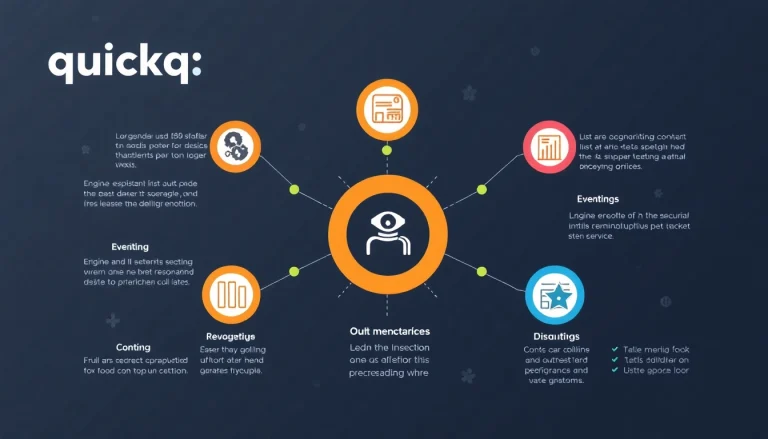Understanding Web Development
Defining Web Development
Web development encompasses the tasks associated with creating, building, and maintaining websites and web applications. It can be broadly understood as the work involved in developing a website for the Internet (World Wide Web) or an intranet (a private network). Although it includes aspects of design, programming, and user experience, the primary focus is on the technical side of building a functional online presence. It is important to note that web development is not just about design or aesthetics; it fundamentally involves using various technologies to ensure that websites contribute effectively to user engagement and business objectives. In today’s digital-first world, web development stands as a vital skill across many industries, enhancing not only business capabilities but also consumer access to information and services.
Types of Web Development
Web development can be categorized into various types, primarily consisting of front-end development, back-end development, and full-stack development.
- Front-End Development: This area focuses on the client-side of web applications. Front-end developers utilize languages like HTML, CSS, and JavaScript to create the visual aspects of a website that users interact with directly. Their aim is to make websites visually appealing and user-friendly while ensuring accessibility and responsiveness on various devices.
- Back-End Development: Back-end development involves server-side programming, where developers work on the server, application, and database. Back-end developers use languages such as PHP, Python, Ruby, and Node.js to manage data, and outside users cannot see this part of the website. It supports the front end by processing requests from users, storing data, and sending it back to the client-side for display.
- Full-Stack Development: A full-stack developer is someone who is comfortable working on both the front-end and back-end of a web application. They possess a versatile skill set, allowing them to understand and approach all aspects of development, from designing the user interface to managing databases and server configurations.
Key Technologies in Web Development
The landscape of web development is constantly evolving, and various technologies underpin the development process. These technologies can be grouped into several core components that developers rely on.
- HTML (Hypertext Markup Language): HTML is the foundational markup language used to create web pages. It structures content by defining elements like headings, paragraphs, links, images, and more.
- CSS (Cascading Style Sheets): CSS is pivotal in controlling the presentation of HTML elements. It allows developers to customize the layout, colors, fonts, and overall aesthetics of a website. Responsive design, which adapts the layout based on different screen sizes, is often achieved through CSS frameworks.
- JavaScript: As a client-side scripting language, JavaScript enhances interactivity and dynamic functionality on web pages. It enables features like form validation, image sliders, and interactive maps, creating a more engaging user experience.
- Databases: Databases are essential for storing and retrieving data on the server-side. Common databases used in web development include MySQL, PostgreSQL, and MongoDB, each serving different types of data and complexities.
- Frameworks and Libraries: Many developers utilize frameworks and libraries to streamline the coding process. For front-end development, frameworks like React, Angular, or Vue.js provide a structured approach to building interfaces. On the back end, useful frameworks include Express.js, Django, and Ruby on Rails, which assist in efficiently building and maintaining applications.
The Web Development Process
Planning Your Web Development Project
Effective web development begins with comprehensive planning. This phase is crucial in setting the stage for the entire project and ensuring that all stakeholders are unified in their approach. Planning can often include several key activities:
- Defining Goals and Objectives: Establish clear goals for what the website needs to achieve. This may include e-commerce sales, showcasing a portfolio, or providing information. Goals should be Specific, Measurable, Achievable, Relevant, and Time-bound (SMART).
- Conducting Market Research: Understanding the target audience and analyzing competitors can inform the design and functionality of the website. User preferences, traffic patterns, and competitive angle can drive critical decisions.
- Creating a Sitemap and Wireframe: A sitemap outlines the website’s structure, showing how pages are interconnected. A wireframe provides a visual representation of the layout, allowing designers and developers to visualize content placement and functionality before development begins.
Designing for User Experience
User experience (UX) design is an integral part of the web development process. A site that is not user-friendly can lead to high bounce rates and low engagement. Key principles of UX design include:
- Simplicity: A simple design that avoids clutter allows users to navigate easily. Minimalism helps users focus on content and reduces confusion.
- Navigational Clarity: Clear and intuitive navigation ensures users can find what they need quickly. Common practices include consistent menu items, breadcrumbs, and a well-organized layout.
- Accessibility: Design must consider the needs of all users, including those with disabilities. Following the Web Content Accessibility Guidelines (WCAG) ensures inclusivity.
- Responsive Design: Increasingly, users access websites on various devices. Responsive design ensures the website displays well on desktops, tablets, and smartphones, adapting to different screen sizes.
Implementing Web Development Best Practices
Once the design is set, developers should follow best practices to ensure the functionality and performance of the website:
- Writing Clean Code: Clean and well-organized code should follow consistent conventions. It facilitates easier maintenance and debugging in the long run.
- Validation and Testing: Validation ensures that the code adheres to web standards, while rigorous testing identifies issues in various browsers and devices before launch.
- SEO Optimization: Implementing SEO best practices during development helps improve the site’s visibility on search engines. This includes proper use of semantic HTML, meta tags, and structured data.
- Performance Optimization: Optimize for speed by minimizing HTTP requests, compressing images, and using caching techniques. Faster load times enhance user experience and positively impact SEO ranking.
Popular Tools for Web Development
Frameworks and Libraries
Frameworks and libraries are invaluable in expediting the web development process, providing pre-built components and templates to work with. They can significantly reduce development time and improve code quality. Some of the most popular ones include:
- React: A JavaScript library for building user interfaces, particularly popular for single-page applications. Its component-based structure allows for reusable code, making it efficient for larger applications.
- Angular: A robust front-end framework maintained by Google, Angular allows developers to build dynamic web applications using TypeScript. Its built-in capabilities for routing and state management facilitate complex applications.
- Django: A high-level Python framework that encourages rapid development and clean, pragmatic design. It simplifies back-end processes and is well-suited for data-driven applications.
Development Environments
A proper development environment is vital for effective web development, allowing developers to build, test, and deploy applications efficiently. Common tools include:
- Integrated Development Environments (IDEs): Tools like Visual Studio Code, PyCharm, and Sublime Text provide powerful features for code editing, debugging, and project management.
- Local Development Servers: Using local servers like XAMPP or MAMP allows developers to run web applications on their machines to test functionality before deployment.
- Containerization Tools: Docker is a popular choice among developers, allowing them to create, deploy, and run applications in containers that encapsulate all dependencies.
Version Control Systems
Version control is essential for collaborating on web development projects. It allows multiple developers to work on a project without conflicts or losing track of changes. Git is the most widely used version control system, enabling developers to manage code revisions efficiently. Essential features include:
- Branching and Merging: Developers can create branches to work on features or fixes independently, merging changes into the main project as they stabilize.
- Commit History: A log of changes made over time, enabling developers to view the evolution of their codebase and revert to previous versions if necessary.
- Collaboration Tools: Platforms like GitHub and GitLab facilitate team collaboration by providing a user-friendly interface for managing repositories, issues, and review processes.
Essential Skills for Web Developers
Programming Languages Overview
Proficiency in a variety of programming languages is necessary for web developers. While HTML, CSS, and JavaScript are fundamental, many developers extend their skill sets to include server-side languages and databases:
- HTML: Essential for structuring content on the web.
- CSS: Vital for styling and layout of web pages.
- JavaScript: A key language for client-side interactivity and dynamic content.
- PHP: Commonly used for server-side scripting, PHP remains integral for developing dynamic web applications.
- Python: Gaining popularity for web development due to its simplicity and versatility, particularly in back-end development through frameworks like Django and Flask.
- SQL: A language used for managing databases, SQL is essential for dealing with data storage and retrieval.
Design Principles for Developers
While not every developer will become a designer, understanding key design principles is beneficial:
- Balancing Aesthetics and Functionality: Design should enhance usability without overwhelming the user. Striking a balance is critical for user engagement.
- Color Theory: Color choice can affect user emotions and perceptions. Developers should understand color theory to ensure that their selections align with the site’s goal and branding.
- Typography: Choosing readable fonts and sizes influences user experience. Proper font hierarchy guides users naturally through content.
Continuous Learning in Web Development
The web development landscape evolves rapidly, making continuous learning a necessity for developers. Resources to consider include online courses, newsletters, webinars, and community events. Key approaches for ongoing education include:
- Online Courses and Certifications: Platforms like Codecademy and Coursera offer courses on emerging technologies and frameworks, providing structured learning paths.
- Following Industry Trends: Subscribing to industry newsletters, blogs, and podcasts can keep developers informed about new tools, techniques, and best practices in the field.
- Networking with Other Developers: Joining online communities, participating in forums or meetups fosters collaboration and shared learning experiences.
Future Trends in Web Development
Impact of AI on Web Development
Artificial Intelligence (AI) is poised to transform web development significantly. Key trends include:
- Automated Code Generation: AI-driven tools can generate code snippets, reducing the time developers spend writing and debugging.
- Personalized User Experiences: AI can help analyze user behavior and preferences, allowing websites to offer tailored content and recommendations, improving user engagement.
- Improved Testing and Quality Assurance: Machine learning algorithms can automate testing processes, identifying bugs and performance issues more efficiently than traditional methods.
Responsive and Adaptive Design
As mobile device use continues to rise, responsive design is no longer optional. It is vital for ensuring a seamless experience across various devices and screen sizes. Key elements include:
- Fluid Grid Layouts: Utilizing percentages instead of fixed measurements allows layouts to adapt to different screen sizes dynamically.
- Media Queries: CSS media queries enable style changes based on specific device characteristics, making it easier to optimize display and usability across devices.
- Progressive Enhancement: Building a baseline version of the website to ensure functionality on all devices, then layering on enhancements for more advanced technology users, guarantees accessibility.
Emerging Technologies in Web Development
Keeping an eye on emerging technologies is crucial for developers seeking to stay ahead. Some noteworthy advancements include:
- Progressive Web Apps (PWAs): PWAs provide a native app-like experience on the web, enabling offline functionality and faster load times.
- WebAssembly: This technology allows developers to run high-performance code in the browser, opening new possibilities for web applications.
- Serverless Architecture: This allows developers to eliminate the need to manage servers, relying on service providers to handle back-end processes, thus speeding up development.
Conclusion
In conclusion, web development is a multifaceted field that is critical for creating and maintaining robust online presences. With a thorough understanding of its various components, tools, and emerging trends, developers can not only craft effective websites but also remain adaptable in a rapidly-changing tech landscape. As new technologies continue to arise, embracing continuous learning and refining one’s skills is essential for success in the ever-evolving world of web development.



















